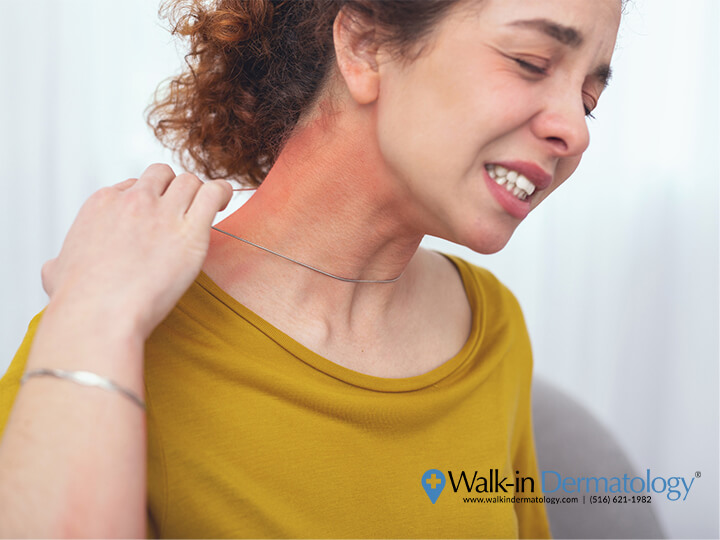Tues: 8:30am - 3:00pm
Wed: 12:00pm - 6:00pm
Thurs: 8:30am - 3:00pm
Fri: Closed
Sat: 8:30am - 12:30pm
Sun: Closed
Greenvale, NY 11548
Fake Jewelry Allergies


An allergic reaction to jewelry usually occurs when your skin comes into contact with certain metals present in your jewelry or piercings. This reaction is commonly known as contact dermatitis, and its main symptom is a red, itchy rash. While this rash isn’t contagious or life-threatening, it can be very uncomfortable.
Most jewelry allergies are caused by the metal nickel, which is used as the base metal for many inexpensive pieces of jewelry. It takes repeated or prolonged exposure to these items before a person develops a nickel allergy, and patients with sensitive skin should avoid products containing nickel as much as possible.
Causes of a Jewelry Allergy
People can be allergic to any metal, but nickel allergies are the most common. The exact cause of this allergy is unknown, but it may develop due to your immune system’s sensitivity to nickel. Ordinarily, your immune system will only fight off bacteria, viruses, and other toxic substances. However, a nickel allergy indicates that your immune system sees this metal as a harmful substance as well.
It may take repeated exposure before your body develops an adverse reaction to nickel, but once it happens your immune system will always respond negatively whenever you come into contact with it. This may also happen with any other metal, even gold.
Aside from wearing cheap jewelry, here are other factors that may increase the risk of developing contact dermatitis:
- Working with metal: If your occupation causes you to come in contact with metal frequently, you are more at risk of developing an allergy. The risk is increases if you’re exposed to wet metals, such as when you sweat or come into contact with water.
- Family history: If you have family members who are sensitive to certain kinds of metal, the chances are high that you will inherit the same type of allergy.
- Being female: Since females traditionally tend to have more piercings, they are more exposed to metal allergies when compared to males.
What Are The Symptoms of an Allergic Reaction?
A jewelry allergy typically begins 24 to 48 hours after being exposed to the item. These symptoms may last for as long as 2 to 4 weeks, and will usually only appear where the metal came into contact with the skin.
The symptoms of a jewelry allergy may resemble a reaction to poison ivy. More specifically, the symptoms that result may include:
- Itching or irritation
- Redness
- Tenderness
- Swelling
- Warmth
- Bumps
- Rashes
- Dry patches that resemble a burn
- Blisters and draining fluid
Are there Any Risks with Inexpensive Jewelry?
When wearing cheap jewelry results in rashes, the rash may become infected with bacteria. This may happen when the skin becomes moist, or if it becomes broken and raw due to scratching. It’s best to see a dermatologist for treatment if your skin becomes crusted, yellow, weeps, or smells odd. The infected rash will not improve until it’s treated.
Treating an Allergic Reaction to Cheap Jewelry
There is no permanent cure for an allergy caused by metal. The best thing that can be done is to avoid certain metals, especially those found in jewelry. Here are some steps you may take to help treat your skin after an allergic reaction:
- Remove the jewelry responsible for the allergy. If you suspect a certain piece of jewelry is causing the problem, it’s best to stop wearing it and observe how your skin reacts.
- Apply a steroid cream on the surface of the rash to help it heal. Your dermatologist may prescribe a corticosteroid cream, nonsteroidal cream, oral corticosteroids, or an oral antihistamine. Medication will help reduce the symptoms and relieve the irritation.
- Emollient creams or soothing lotions such as calamine lotion, petroleum jelly, or mineral oil can help ease the itching. It’s also important to moisturize regularly, since your skin’s natural barrier has been disrupted by the allergens.
- A wet compress can help soothe your blisters and relieve the itching. You can soak a clean cloth in tap water, then apply it onto the affected area of the skin.
- Avoid over-the-counter ointments like antibiotic creams, as these may contain ingredients such as neomycin which can worsen an allergic reaction.
- For patients whose allergies do not get better with topical or oral steroids, phototherapy is another treatment you can try. A phototherapy procedure involves exposing the skin to a controlled amount of artificial UV light.
Tips For Wearing Costume Jewelry
When you are diagnosed with some form of allergy to metal, it’s important to stay away from jewelry and other accessories containing that metal.
However, this is easier said than done as many jewelry products contain metals like nickel. Silver or gold plated jewelry contain nickel alloys underneath. Any gold jewelry that is less than 24K, such as white gold, will also contain a mixture of metals to provide structure to soft, pure gold.
Here are some ways you can continue to wear inexpensive jewelry and keep your skin safe at the same time:
Purchase hypoallergenic jewelry
If you’re allergic to a specific metal, be sure to check that the jewelry you plan to buy does not contain that metal. Look for hypoallergenic jewelry such as nickel-free stainless steel, surgical-grade stainless steel, titanium, platinum, sterling silver, and 18K gold. Avoid buying jewelry plated with another metal or made of mixed metals like white gold.
Create barriers for your skin
Creating barriers will help you reduce the risk of an allergic reaction while handling metals. For example, use gloves if you’re working with metals. With jewelry, three coats of clear nail polish can do the trick. Apply the clear nail polish on the part of the jewelry that comes into contact with your skin, so you limit the amount of irritants that interact with body heat and sweat. Be sure to reapply additional coats of polish after a few wears.
Visit a reputable piercing studio
If you’re planning to get piercings done, make sure to choose a studio that provides piercing services in a clean and professional environment. Check if the studio uses sterile, sealed surgical-grade stainless steel needles. Piercing guns should also be maintained so that the part touching a customer’s skin will not be used on other customers. Ask your piercer for hypoallergenic jewelry made of sterling silver or similar metals, and see if they can provide documentation on the metal content of their products.
Consult With Walk-in Dermatology Today
If you’re having a problem with the jewelry you wear, consult with us at Walk-in Dermatology. Let our team of dermatologists help you figure out what type of jewelry you can safely wear, and treat any skin issues you might be experiencing. Schedule an appointment now.








